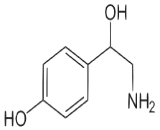Octopamine (OA)
Epirenor; Norden; Norfen; β,4-Dihydroxyphenethylamine

Octopamine, also known as β,4-dihydroxyphenethylamine, is an endogenous biogenic amine that is closely related to norepinephrine, and has effects on the adrenergic and dopaminergic systems. Biosynthesis of the D(-)-enantiomer of octopamine is by β-hydroxylation of tyramine via the enzyme dopamine β-hydroxylase. Under the trade names Epirenor, Norden, and Norfen, octopamine is also used clinically as a sympathomimetic agent.
Octopamine was first discovered by Italian scientist Vittorio Erspamer in 1948 in the salivary glands of the octopus and has since been found to act as neurotransmitter, neurohormone and neuromodulator in invertebrates. It is widely used in energy-demanding behaviours by all insects, crustaceans (crabs, lobsters, crayfish), and spiders. Such behaviours include flying, egg-laying, and jumping.
Organism species: Pan-species (General)
- Conjugated small molecules CPG048Ge21 OVA Conjugated Octopamine (OA) In Stock
- Polyclonal antibody PAG048Ge01 Polyclonal Antibody to Octopamine (OA) In Stock
- Customized Service n/a CLIA Kit for Octopamine (OA) CLIA Kit Customized Service Offer
- Customized Service n/a ELISA Kit for Octopamine (OA) ELISA Kit Customized Service Offer


